6.7 Exchange/O365 Profile
The job will need an Exchange profile setup to connect to the email system properly.
This requires that the module be configured Exchange Module: Office365 or Exchange Module: On-Premise Exchange.
After the Exchange Module has been configured, the Exchange Profile will be available for configuration. If an Exchange Profile is not configured, jobs cannot be run against the Exchange system.
Click on “Add Profile” and provide a profile name, or select an already existing profile to access the configuration tabs. All changes made on this page must be saved by selecting the “save changes”, disk icon, at the top right of the page. Tabs may be changed and navigated through without affecting new settings, but any move to another page will require saving, or abandoning the changes made.
6.7.1 Skype for Business
With O365, Retain will also archive Skype for Business conversations. They will be saved to the Conversation History folder of the user.
6.7.2 Core Settings Tab
The core settings consist of an enabled/disabled option which must be enabled for any jobs based on this profile to archive anything.
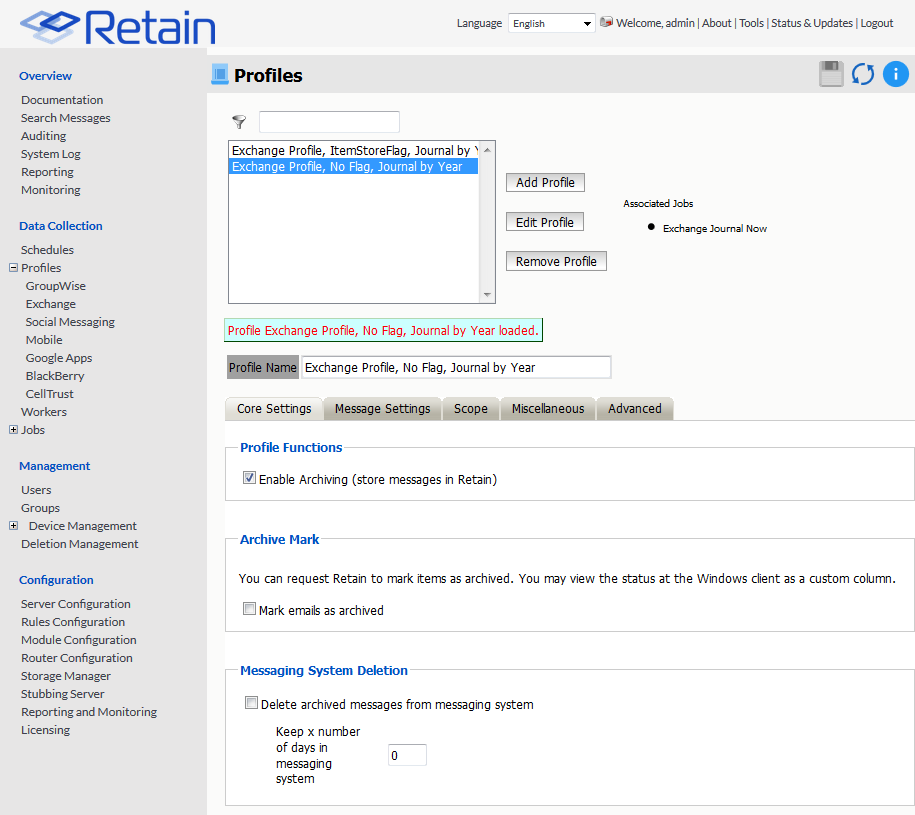
Profile Functions
The Profile Functions tell the Retain Server what to do with the mail it archives from the messaging system. If Archiving is not enabled, mail will not be archived by Retain.
Archive Mark
Some users may opt to use the Archive Mark for messages that have been archived by Retain. The archive mark is a custom flag and may be modified, therefore is not secure and should not be used for compliance. Archive Mark slightly degrades job performance. Check the check box to enable Archive Mark for the selected profile.
When the Archive Mark is active, Retain creates a custom column for mail, called “RetainArchived” which users and administrators may add to their email client to view mail which has been archived. The “RetainArchived” column indicates an archived mail item by displaying a ‘1’ in the message row, while remaining blank when the message is not archived.
Messaging System Deletion
For systems where the administrator wishes to have archived messages removed from the system automatically, the Messaging System Deletion option may be used. Messaging System Deletion will remove messages from a mailbox after they are archived, according to the time frame specified in the settings. The amount of time to keep messages is specified in days. The recommended setting depends on the archiving scheme in the system. For example, if messages are to persist in the system for 30 days, then the system deletion setting should be set to 30 and enabled. A setting of 0 will remove messages from the system as soon as they are archived. Be sure to configure the system before enabling the setting in the profile.
However, it is recommended that the messaging system do the deletion rather than Retain.
6.7.3 Message Settings Tab
Retain can archive and select specific types of mail and Exchange system items to be archived. The Manage Settings tab provides access to manage those settings.
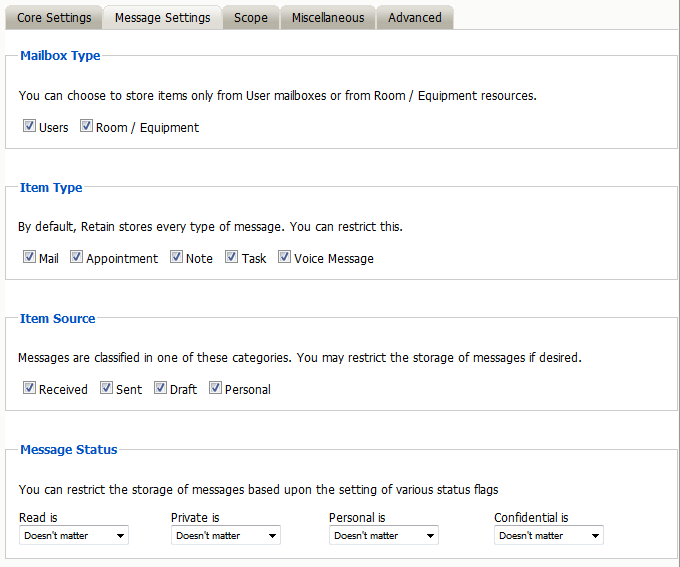
The Mailbox type specifies whether to include or exclude the available types of mailboxes. Because there can be multiple profiles and jobs, it may be advantageous to archive the Users and Room / Equipment mailboxes separately as needed and appropriate for the system.
The Item Type option specifies the different types of messages found in Exchange that can be archived, and allows the exclusion of or inclusion of the different individual types.
The Item Source option allows administrators to exclude or include messages that have not yet been sent or received, or posted.
The Message Status allows messages which have or have not been read or opened, or marked private or confidential to be archived. The different options in the drop-down menu are as shown.

6.7.4 Scope Tab
The Scope tab dictates the date range Retain will scan in the attached archiving jobs.
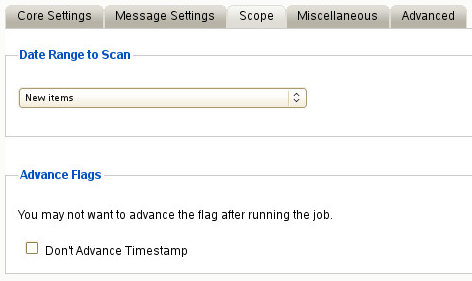
Date Range to Scan
The Date Range to Scan instructs Retain to scan for, and archive, messages after, or before, a certain date. This is useful if only specific chunks or areas of mail are to be archived.

New Items: All items that have not been archived by Retain since the last time the job ran.
All Items in Mailbox: All items in the mailbox starting from 1/1/1970, duplicates will be processed but not stored if they already exist in Retain's archive.
Number of days before job start date and newer: Only items from the relative number of days from the time the job began will be archived. E.g. messages that came into the email system less than 7 days ago.
Number of days from job start date and older: Only items previous to the relative number of days from the time the job began will be archived. E.g. messages that came into the email system more than 7 days ago.
Specify custom date range: Only items between two absolute dates will be dredged.
Specify custom date range relative to job start: Only items between two relative dates will be dredged. E.g. messages that came into the email system between 7 and 5 days ago.
It is recommended to archive all New items.
Advance Flags
Enabling "Don't Advance Timestamp" will not update the timestamp flag. Items that are dredged will still be considered new by Retain the next time the job runs.
This is useful when troubleshooting, but is generally not used for normal jobs.
NOTE:Unlike GroupWise, Exchange does not ensure any compliance when scanning end user mailboxes; users may freely delete their email. The Item store flag does not prevent mail deletion. Only setting a rolling hold on all mailboxes guarantees all items have been archived.
6.7.5 Miscellaneous Tab
The Miscellaneous tab allows access to settings detailing how messages are stored and what is archived. Attachments, message information such as the Internet headers, and how the data is stored and named, (by folders, year, or year and month), dictate not only the message store structure, but affect the storage size.
Miscellaneous options also allow for the archiving of the ‘recoverable items’. To enable checking and archiving of the ‘Recoverable Items’ for compliance reasons, select the checkbox next to the option.
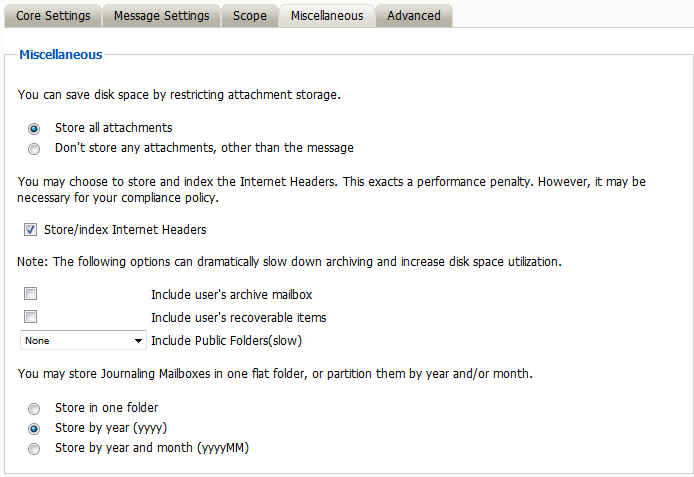
6.7.6 Advanced Tab
The Advanced tab allows you to limit what is stored by Retain. This must be used with caution as this opens holes for data to be lost through. It is recommended to store everything since storage space is inexpensive.
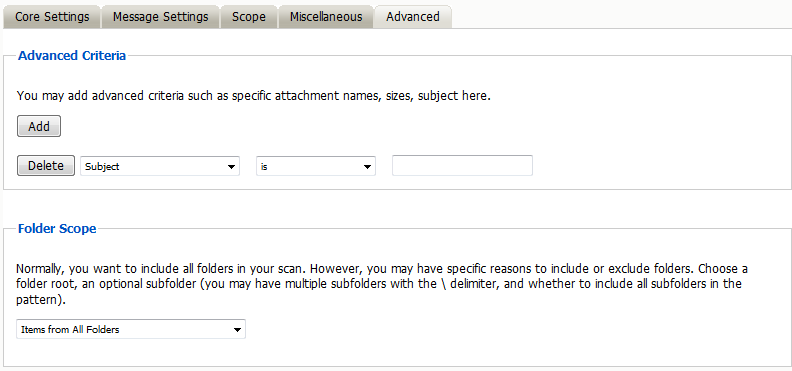
Advanced Criteria
If you want to be more specific as to what to dredge or not to dredge, add the criteria here.
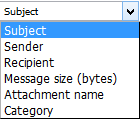
Each line will be logically AND-ed together. Think “Dredge all items where the following is true:” Criteria A AND Criteria B AND Criteria C AND etc.
You may select based on:
-
Subject
-
Sender
-
Recipient
-
Message size (in bytes)
-
Attachment name
-
Category
And whether they are is, is not, contains, or does not contain the items specified.
This provides flexibility and granularity. It allows customized dredges and retention for many different groups, or even individuals.
Folder Scope
By default, we dredge items from all folders. You can specify one or more inclusions or exclusions.

Your choices are:
-
Dredge everything
-
Dredge only these listed folders
-
Dredge everything except these listed folders
How to specify the list of folders to dredge/exclude:
-
Specify a System Folder (mandatory). Example: Calendar.
-
You specify a subfolder of that folder (optional).
Example: entering “old” would mean the folder “old” under “Calendar”.
-
You can have multiple hierarchies under that with the / delimiter.
Example: “old/mail” would mean the subfolder “mail” under “old” under “Calendar”.
-
You specify if the option includes subfolder.
Example: If you select “old” and “includes subfolder” is unchecked, “Calendar/mail” is selected. If “includes subfolder” is CHECKED, “Calendar/old/mail” would also be selected.
You may now configure a Job Exchange/O365 Job.